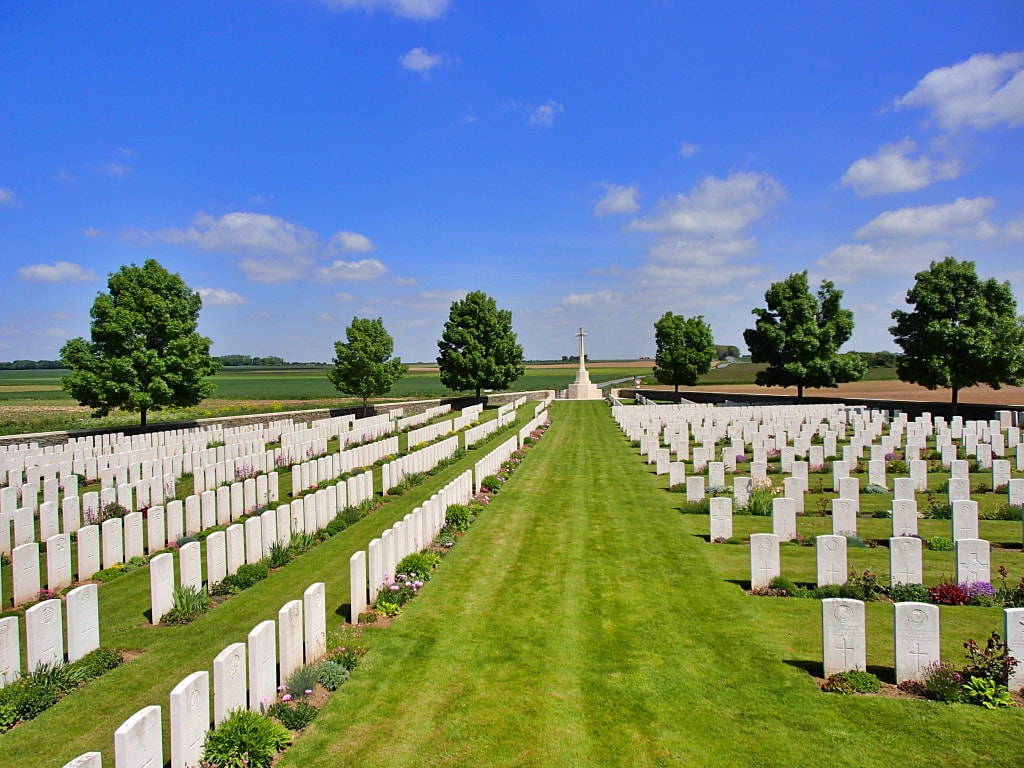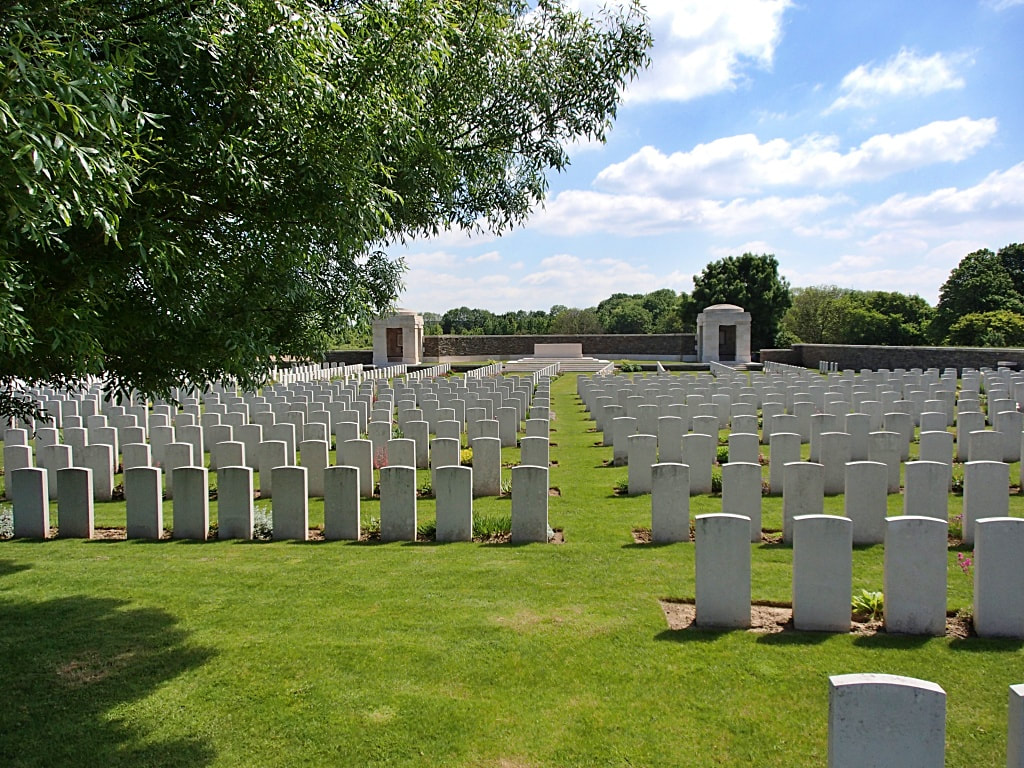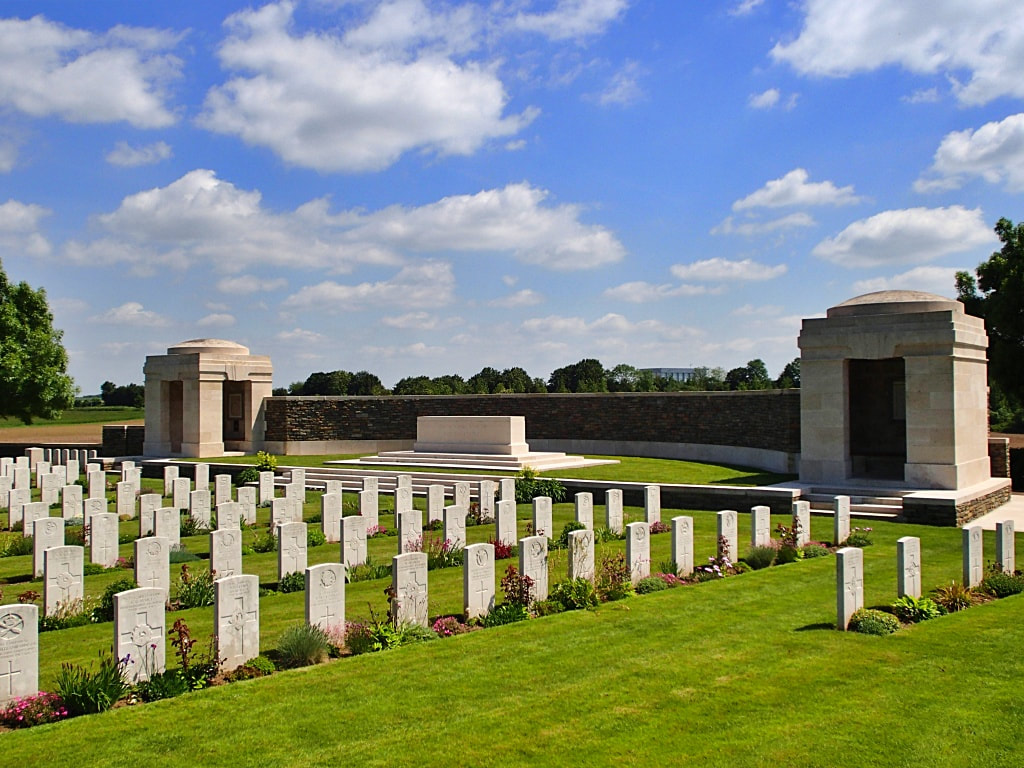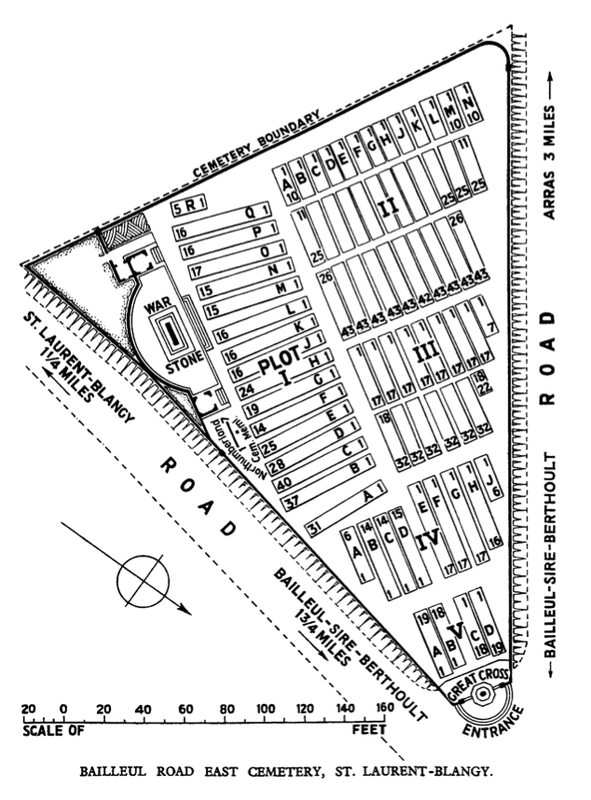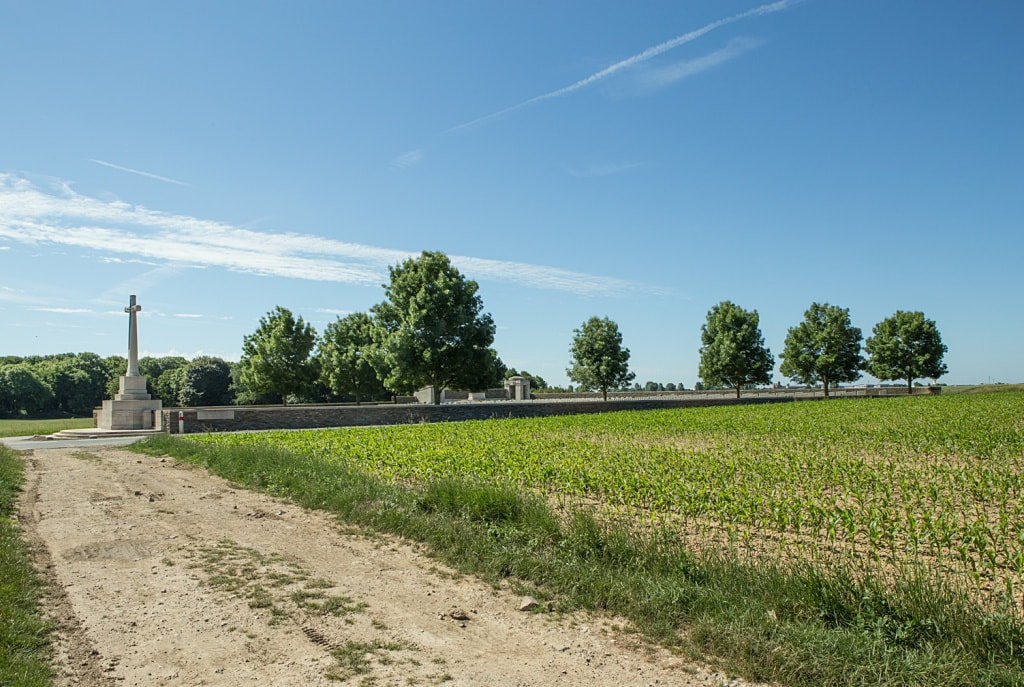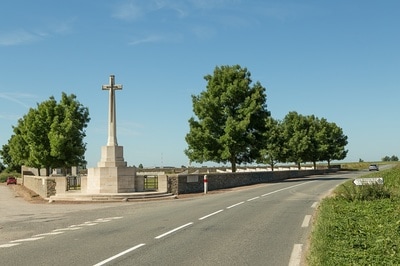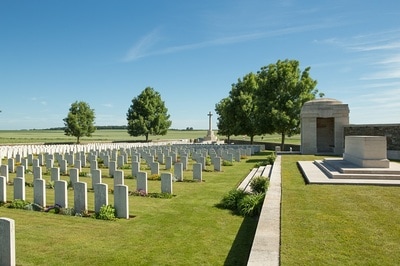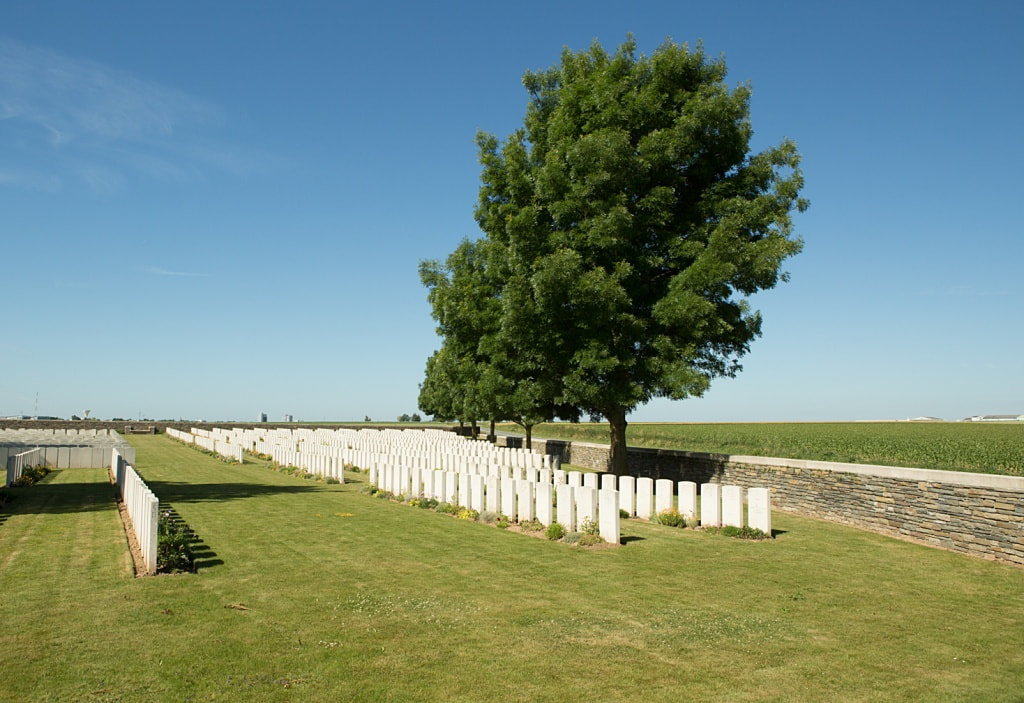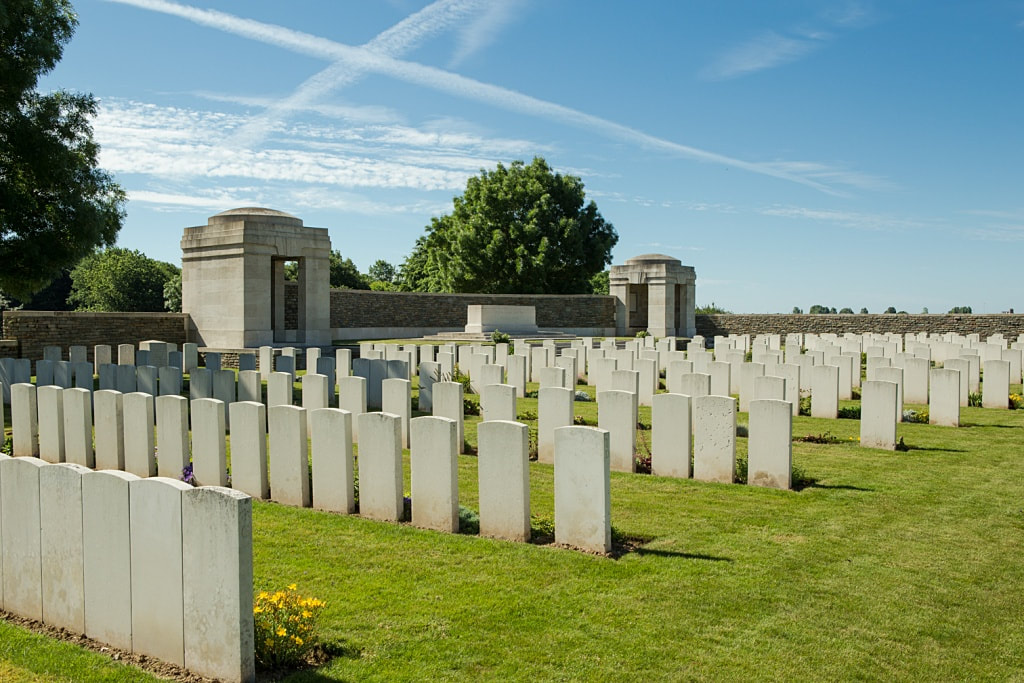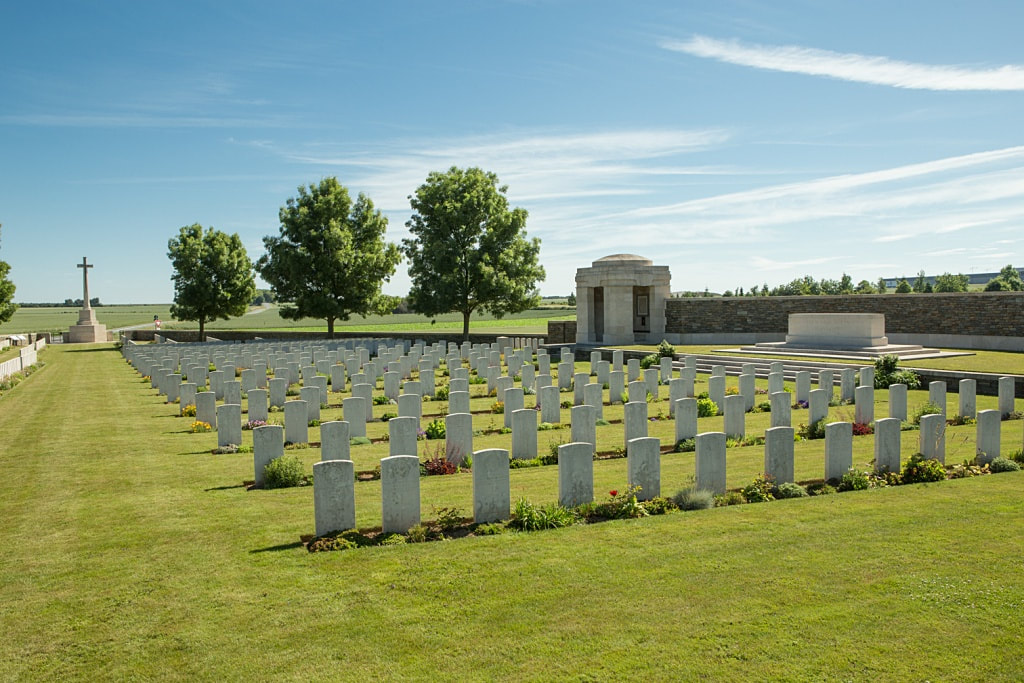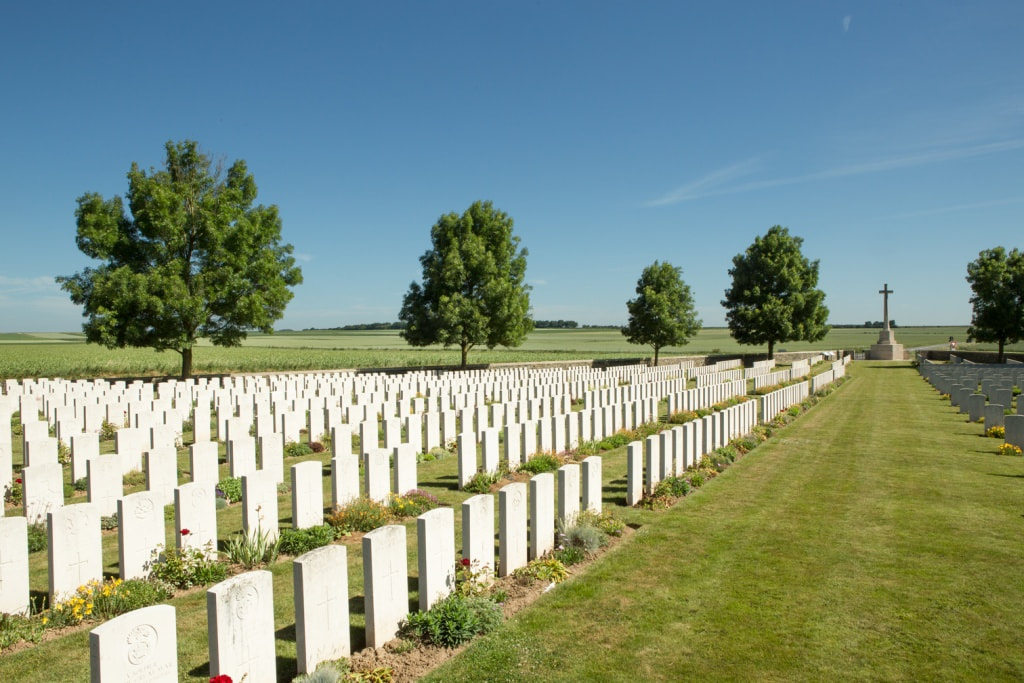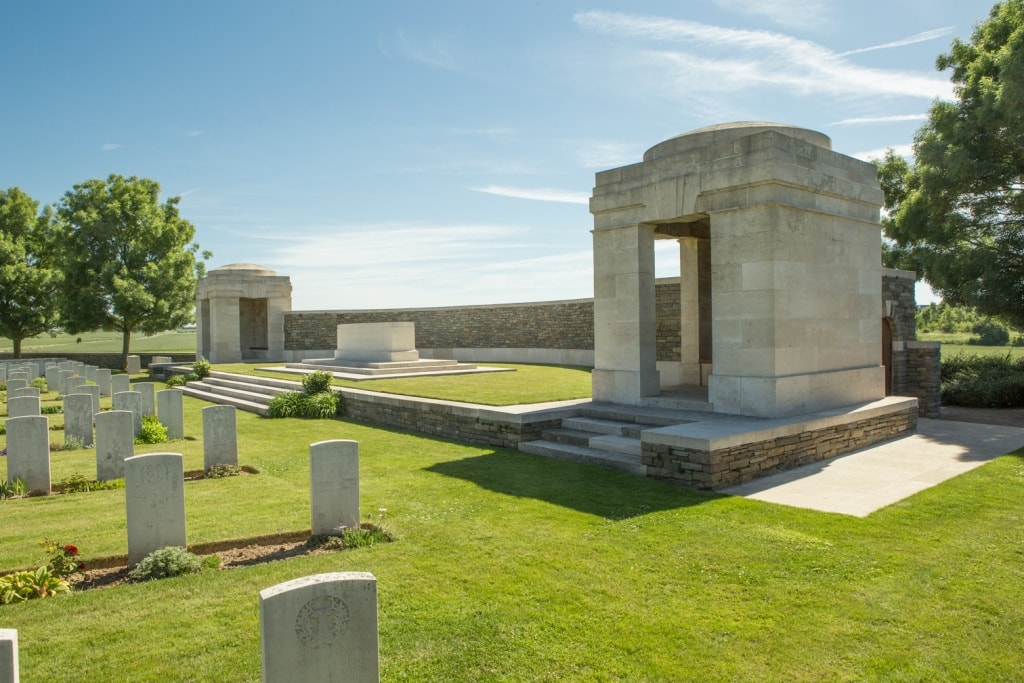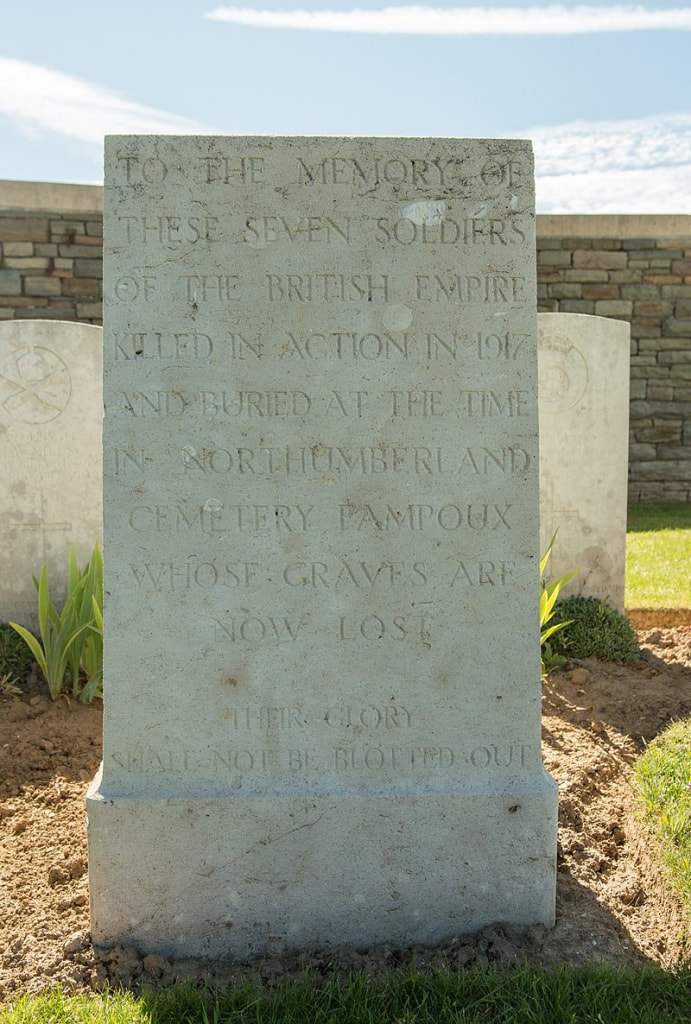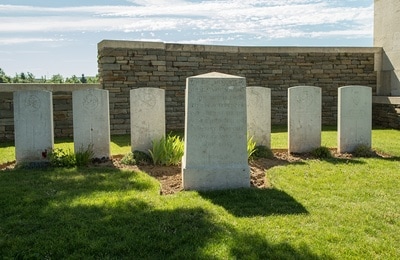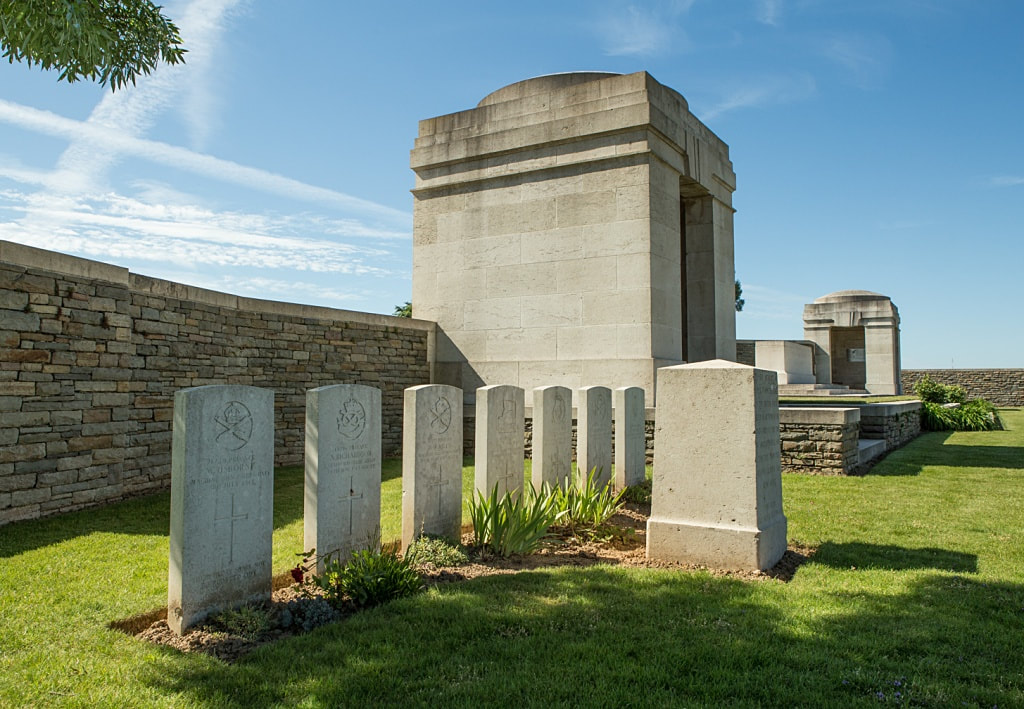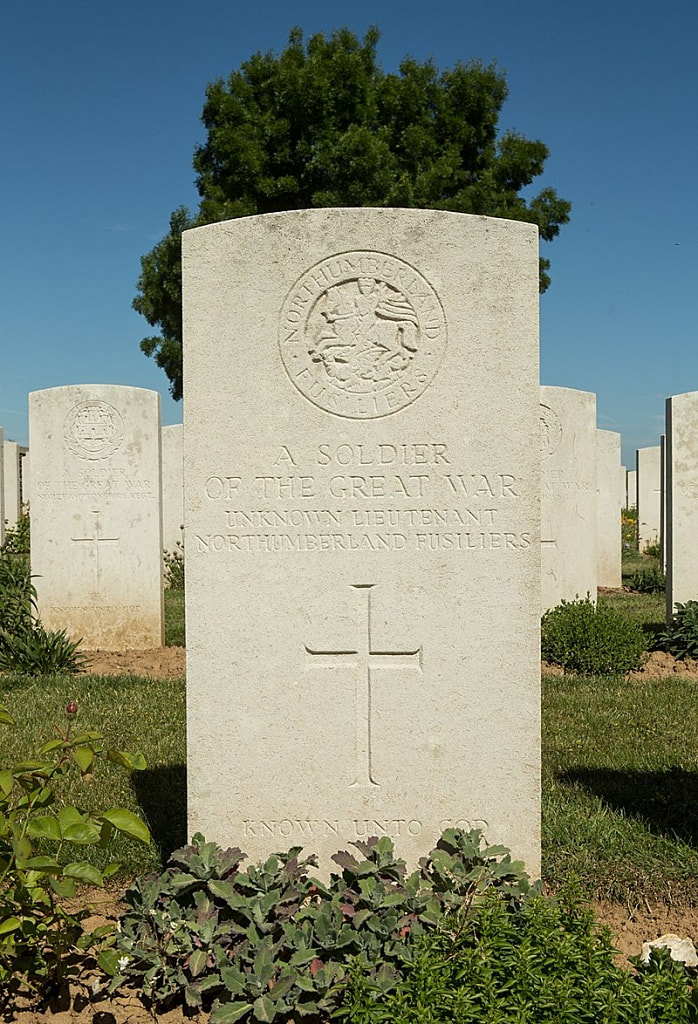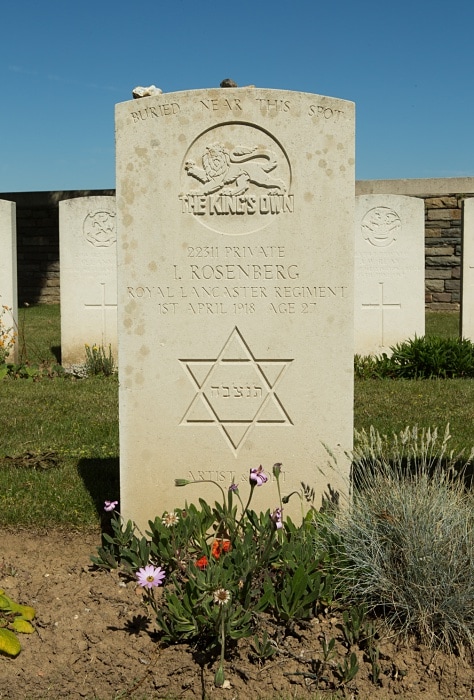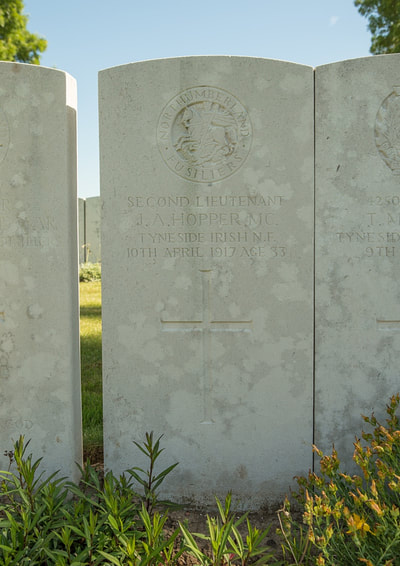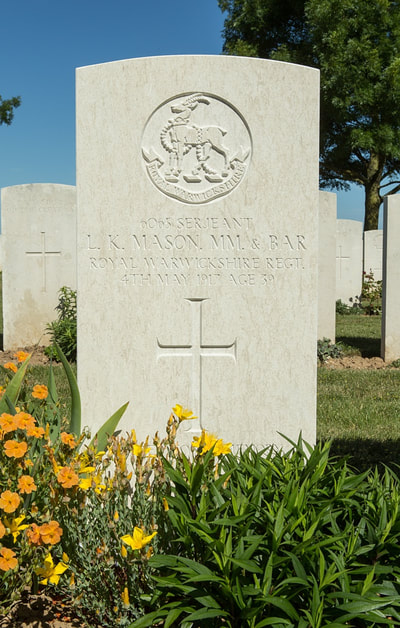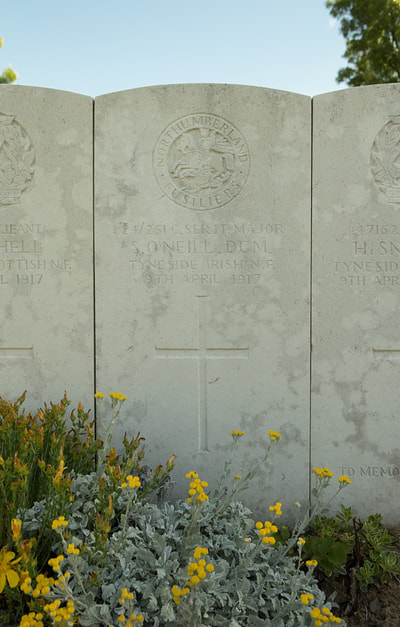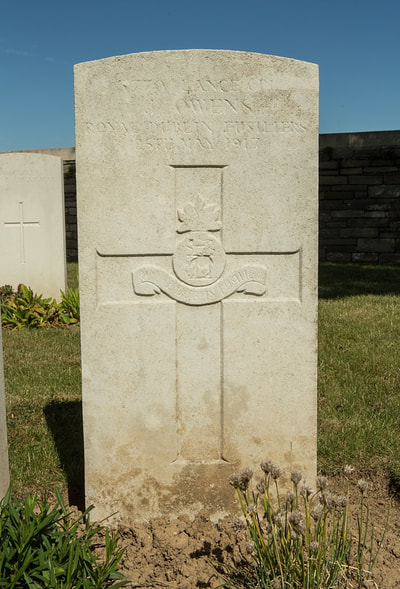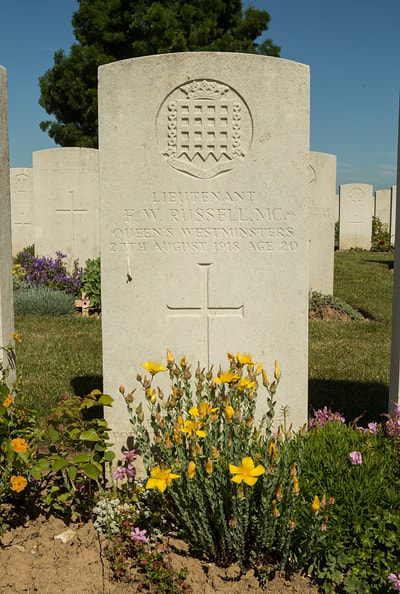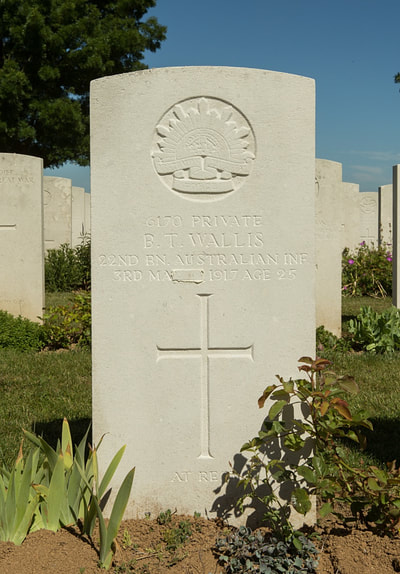BAILLEUL ROAD EAST CEMETERY
St. Laurent-Blangy
Pas De Calais
France
GPS Coordinates: Latitude: 50.31993, Longitude: 2.81669
Location Information
St. Laurent-Blangy is a village adjoining the north-east side of Arras. Leave St. Laurent-Blangy on the D919 towards Bailleul-sire-Berthoult for about 2.5 Kms. Bailleul Road East Cemetery is about 2 Kms north-east of the village on the south side (right) of the road.
Historical Information
A greater part of the village was included in the front taken over by British troops in March, 1916, and the remainder fell into British hands on the first day of the Battles of Arras, the 9th April, 1917.
Bailleul Road East Cemetery was begun by the 34th Division in April, 1917, and carried on by fighting units until the following November; and Plot I, Row R, was added in August, 1918. Plots II, III, IV and V were made after the Armistice by the concentration of isolated graves from a very wide area North, East and South of Arras and from the following two burial grounds:-
NORTHUMBERLAND CEMETERY, FAMPOUX, was on the West side of the road from Fampoux to Bailleul-Sire-Berthoult. This road was called Northumberland Lane, and a neighbouring trench was called Northumberland Avenue. The cemetery was used by fighting units from April to July, 1917, and one other burial was made in it in September, 1918. It contained the graves of 69 soldiers from the United Kingdom, and these (except seven, which were not found) were concentrated into Plot V of Bailleul Road East Cemetery.
LAGNICOURT "SOLDIERS' CEMETERY" (the German name) was near the South-East side of the village of Lagnicourt. It contained the grave of one R.F.C. Officer who fell in October, 1916.
There are 1,298, 1914-18 war casualties commemorated in this site. Of these, 753 are unidentified, and seven special memorials record the names of soldiers from the United Kingdom buried in Northumberland Cemetery, Fampoux, whose graves could not be found on concentration; and a number of graves in Plot V, identified as a whole but not individually, are marked by headstones bearing the additional words, "Buried near this spot". Every year of the war is represented in the cemetery, but more particularly the last nine months of 1917.
The cemetery covers an area of 4,486 square metres and is enclosed by a rubble wall and was designed by Sir Reginald Blomfield and Noel Ackroyd Rew.
Total Burials: 1,298.
Identified Casualties: United KIngdom 520, Australia 13, Canada 4, South Africa 4. Total 541.
Unidentified Casualties: United Kingdom 711, Australia 30, Canada 9, South Africa 2, Unknown 1. Total 753.
Images in gallery below © Werner Van Caneghem
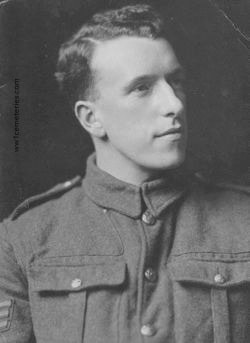
17015 Sergeant
William Scott Alexander
15th Bn. Royal Scots
18th June 1917.
Plot V. B. 9.
William Scott Alexander
15th Bn. Royal Scots
18th June 1917.
Plot V. B. 9.
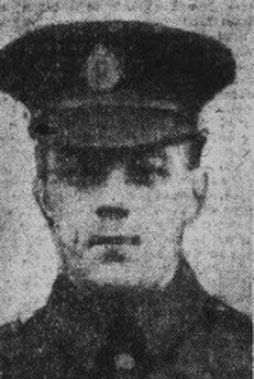
5770 Corporal
Joseph Owens
1st Bn. Royal Dublin Fusiliers
25th May 1917.
Plot III. E. 32.
Joseph Owens
1st Bn. Royal Dublin Fusiliers
25th May 1917.
Plot III. E. 32.
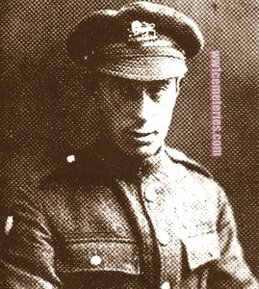
22311 Private
Isaac Rosenberg
1st Bn. King's Own (Royal Lancaster Regiment)
1st April 1918, aged 27.
Sp. Mem. V. C. 12. Buried near this spot.
Son of Barnet and Annie Rosenberg, of 87, Dempsey St., Stepney, London. Born at Bristol. Some critics of the time considered Rosenberg the best of the war poets after Wilfred Owen.
Break of Day in the Trenches by Isaac Rosenberg
The darkness crumbles away.
It is the same old druid Time as ever,
Only a live thing leaps my hand,
A queer sardonic rat,
As I pull the parapet’s poppy
To stick behind my ear.
Droll rat, they would shoot you if they knew
Your cosmopolitan sympathies.
Now you have touched this English hand
You will do the same to a German
Soon, no doubt, if it be your pleasure
To cross the sleeping green between.
It seems you inwardly grin as you pass
Strong eyes, fine limbs, haughty athletes,
Less chanced than you for life,
Bonds to the whims of murder,
Sprawled in the bowels of the earth,
The torn fields of France.
What do you see in our eyes
At the shrieking iron and flame
Hurled through still heavens?
What quaver—what heart aghast?
Poppies whose roots are in man’s veins
Drop, and are ever dropping;
But mine in my ear is safe—
Just a little white with the dust.
Isaac Rosenberg
1st Bn. King's Own (Royal Lancaster Regiment)
1st April 1918, aged 27.
Sp. Mem. V. C. 12. Buried near this spot.
Son of Barnet and Annie Rosenberg, of 87, Dempsey St., Stepney, London. Born at Bristol. Some critics of the time considered Rosenberg the best of the war poets after Wilfred Owen.
Break of Day in the Trenches by Isaac Rosenberg
The darkness crumbles away.
It is the same old druid Time as ever,
Only a live thing leaps my hand,
A queer sardonic rat,
As I pull the parapet’s poppy
To stick behind my ear.
Droll rat, they would shoot you if they knew
Your cosmopolitan sympathies.
Now you have touched this English hand
You will do the same to a German
Soon, no doubt, if it be your pleasure
To cross the sleeping green between.
It seems you inwardly grin as you pass
Strong eyes, fine limbs, haughty athletes,
Less chanced than you for life,
Bonds to the whims of murder,
Sprawled in the bowels of the earth,
The torn fields of France.
What do you see in our eyes
At the shrieking iron and flame
Hurled through still heavens?
What quaver—what heart aghast?
Poppies whose roots are in man’s veins
Drop, and are ever dropping;
But mine in my ear is safe—
Just a little white with the dust.
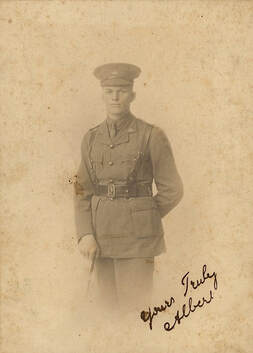
Second Lieutenant
Albert Henry Tiegs
28th Bn. Australian Infantry, A.I.F.
26th March 1917, aged 23.
Plot III. C. 10.
Son of Albert Frederick and Caroline Johanna Tiegs, of Port Curtis Rd., Rockhampton, Queensland.
Click on image to enlarge
His headstone bears the inscription "Gone But Not Forgotten"
Studio portrait of Private Albert Henry Tiegs, 11th Battalion. Tiegs enlisted as a private with the 11th Battalion in 1914 and was wounded on the first day of the Gallipoli landings. He was hospitalised on Malta and subsequently returned to Australia. Upon his recovery he re-enlisted and was commissioned as a Second Lieutenant (2nd Lt). He embarked with the 28th Battalion in October 1916 for service in France. Tiegs' unit was supporting the 26th Battalion in an attack on Lagnicourt on 26 March 1917 when 2nd Lt Tiegs was killed in action.
Albert Henry Tiegs
28th Bn. Australian Infantry, A.I.F.
26th March 1917, aged 23.
Plot III. C. 10.
Son of Albert Frederick and Caroline Johanna Tiegs, of Port Curtis Rd., Rockhampton, Queensland.
Click on image to enlarge
His headstone bears the inscription "Gone But Not Forgotten"
Studio portrait of Private Albert Henry Tiegs, 11th Battalion. Tiegs enlisted as a private with the 11th Battalion in 1914 and was wounded on the first day of the Gallipoli landings. He was hospitalised on Malta and subsequently returned to Australia. Upon his recovery he re-enlisted and was commissioned as a Second Lieutenant (2nd Lt). He embarked with the 28th Battalion in October 1916 for service in France. Tiegs' unit was supporting the 26th Battalion in an attack on Lagnicourt on 26 March 1917 when 2nd Lt Tiegs was killed in action.
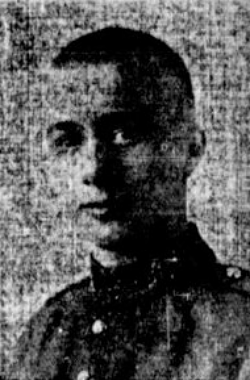
160506 Private
George Arthur Towson
10th Bn. Canadian Infantry
9th April 1917, aged 21.
Plot II. C. 3.
Son of Walter Towson, of 2433. First St. East, Calgary, Alberta.
His headstone bears the inscription "All's Well For Here At Last He With His Comrades Sleeps"
George Arthur Towson
10th Bn. Canadian Infantry
9th April 1917, aged 21.
Plot II. C. 3.
Son of Walter Towson, of 2433. First St. East, Calgary, Alberta.
His headstone bears the inscription "All's Well For Here At Last He With His Comrades Sleeps"

